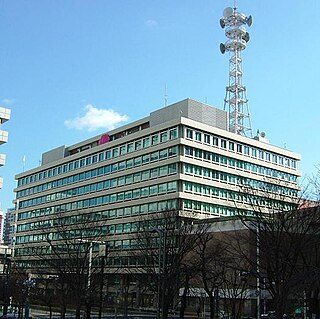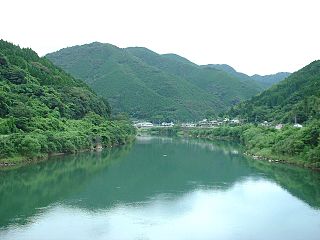
Robert Alexander Szatkowski is an American professional wrestler and actor better known by his ring name Rob Van Dam He is known for his tenures in Extreme Championship Wrestling (ECW), World Wrestling Entertainment (WWE), and Impact Wrestling.

The Hida Mountains, or Northern Alps, is a Japanese mountain range which stretches through Nagano, Toyama and Gifu prefectures. A small portion of the mountains also reach into Niigata Prefecture. William Gowland coined the phrase "Japanese Alps" during his time in Japan, but he was only referring to the Hida Mountains when he used that name. The Kiso and Akaishi mountains received the name in the ensuing years.

Minakami is a town located in Gunma Prefecture, Japan. As of 31 October 2020, the town had an estimated population of 18,383 in 7938 households, and a population density of 24 persons per km². The total area of the town is 781.08 square kilometres (301.58 sq mi). Much of the town is within the borders of Jōshin'etsu-kōgen National Park.

The Kurobe Dam (黒部ダム) or Kuroyon Dam (黒四ダム), is a 186 m (610 ft) high variable-radius arch dam on the Kurobe River in Toyama Prefecture, Japan. The tallest dam in Japan, it supports the 335 MW Kurobe No. 4 Hydropower Plant and is owned by Kansai Electric Power Company. It was constructed between 1956 and 1963 at a cost of 51.3 billion yen. The project was a difficult engineering feat for the rapidly growing post–World War II Japan, and claimed the lives of 171 people.

The Shinano River, known as the Chikuma River in its upper reaches, is the longest and widest river in Japan and the third largest by basin area. It is located in northeastern Honshu, rising in the Japanese Alps and flowing generally northeast through Nagano and Niigata Prefectures before emptying into the Sea of Japan.

Saru River is a river in Hokkaidō, Japan.

Malampuzha Dam is the second largest dam and reservoirs in Kerala, located near Palakkad, in the state of Kerala in South India, built post independence by the then Madras state. Situated in the scenic hills of the Western Ghats in the background it is a combination of a masonry dam with a length of 1,849 metres and an earthen dam with a length of 220 metres making it the longest dam in the state. The dam is 355 feet high and crosses the Malampuzha River, a tributary of Bharathappuzha, Kerala's second longest river. There is a network of two canal systems that serve the dam's reservoir of 42,090 hectares.

Chubu Electric Power Co., Inc., abbreviated as Chuden in Japanese, is a Japanese electric utilities provider for the middle Chūbu region of the Honshu island of Japan. It provides electricity at 60 Hz, though an area of Nagano Prefecture uses 50 Hz. Chubu Electric Power ranks third among Japan's largest electric utilities in terms of power generation capacity, electric energy sold, and annual revenue. It is also one of Nagoya's "four influential companies" along with Meitetsu, Matsuzakaya, and Toho Gas. Recently, the company has also expanded into the business of optical fibers. On January 1, 2006, a new company, Chubu Telecommunications, was formed.

The Shō River has its source in Mount Eboshi in the Shōkawa-chō area of Takayama, Gifu Prefecture, Japan. After flowing for 115 km (71 mi) through the northern part of Gifu Prefecture and the western part of Toyama Prefecture, it empties into Toyama Bay.

Mitsuishi River is a river in Hokkaido, Japan. It is 31.6 kilometers (19.6 mi) in length and has a drainage area of 159.4 square kilometers (61.5 sq mi).

The Gōnokawa River is a river that runs through Hiroshima and Shimane prefectures in Japan. It is the largest river in the Chūgoku region. It is also called the Gōgawa River and, in Hiroshima, the Enokawa River.

Detective Conan: Quarter of Silence is the fifteenth film installment of the manga and anime series Case Closed. The film was released on April 16, 2011. This film celebrates the fifteenth anniversary of the anime. Magic File 2011, ties in with the film and was released on the same day as the film's premiere.
Water supply and sanitation in Japan is characterized by numerous achievements and some challenges. The country has achieved universal access to water supply and sanitation; has one of the lowest levels of water distribution losses in the world; regularly exceeds its own strict standards for the quality of drinking water and treated waste water; uses an effective national system of performance benchmarking for water and sanitation utilities; makes extensive use of both advanced and appropriate technologies such as the jōkasō on-site sanitation system; and has pioneered the payment for ecosystem services before the term was even coined internationally. Some of the challenges are a decreasing population, declining investment, fiscal constraints, ageing facilities, an ageing workforce, a fragmentation of service provision among thousands of municipal utilities, and the vulnerability of parts of the country to droughts that are expected to become more frequent due to climate change.

The Fujinuma Dam, was an earth-fill embankment dam in Sukagawa City, Fukushima Prefecture, Japan. It was established on the Ebana River, a tributary of the Abukuma River, 16 km (10 mi) west of the city office of Sukagawa City. Construction on the dam commenced in 1937 and it was completed in 1949 after construction was halted due to World War II. The dam's primary purpose was irrigation. It failed on 11 March 2011 after the 2011 Tōhoku earthquake.

The Shin-Takasegawa Pumped Storage Station (新高瀬川発電所) uses the Takase River to operate a pumped storage hydroelectric scheme about 12 kilometres (7.5 mi) west of Ōmachi in Nagano Prefecture, Japan. Part of the system is within Chūbu-Sangaku National Park.
Bodai Dam is a gravity dam located in Chiba Prefecture in Japan. The dam is used for irrigation and water supply. The catchment area of the dam is 6.7 km2. The dam impounds about 25 ha of land when full and can store 2740 thousand cubic meters of water. The construction of the dam was started on 1983 and completed in 1998.
Yamauchi Dam is an earthfill dam located in Chiba Prefecture in Japan. The dam is used for irrigation. The catchment area of the dam is 0.6 km2. The dam impounds about 90 ha of land when full and can store 360 thousand cubic meters of water. The construction of the dam was started on 1997 and completed in 2004.
Tonogawa Dam(Japanese: 殿川ダム) is a gravity dam located in Kagawa Prefecture in Japan. The dam is used for flood control and water supply. The catchment area of the dam is 5.6 km2. The dam impounds about 6 ha of land when full and can store 690 thousand cubic meters of water. The construction of the dam was started on 1967 and completed in 1974.















